Spoon swimming
How pros catch bass swimming metal
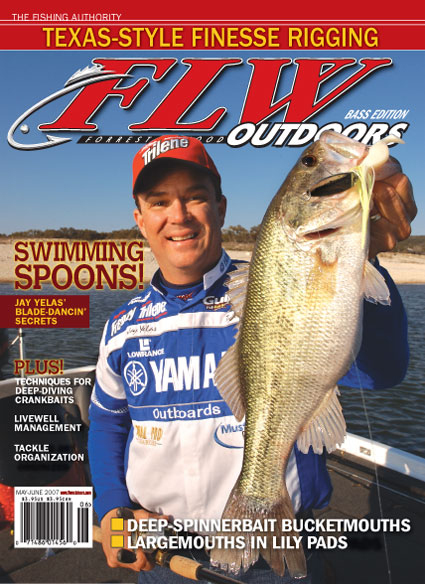
FLW Outdoors National Guard pro Scott Martin of Clewiston, Fla., has known about the Johnson Silver Minnow practically since he was old enough to say the word “bass.” While growing up at Roland and Mary Ann Martin’s Marina and Resort on the shore of Lake Okeechobee, he listened to countless tails from weathered old fishermen. They mainly spoke of three things – wild shiners, Johnson spoons and big bass.
Martin hasn’t forgotten those stories. He still catches heavyweight bass on wild shiners while guiding and on Johnson spoons when fishing tournaments.
Though swimming a spoon through grass has been catching bass for generations, it has taken a backseat to new lures and techniques. But, spoon swimming is making a comeback thanks to new models introduced by Stanley and Berkley that mold a jighead to a spoon blade. This design results in a more aggressive wobbling action. Some FLW Outdoors pros are even having success fishing these spoons around hard cover, such as boat docks.
Martin, however, dotes on the venerable Johnson spoon. He’s made a science of fishing it on Okeechobee and other lakes where grass is the prevailing bass cover.
“The Johnson spoon is a great search bait because you can cover water very quickly with it,” Martin said. “It’s designed so well that it comes through thick grass better than any other lure.”
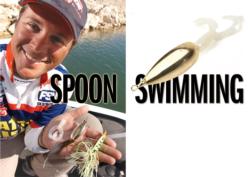 Since the Johnson spoon is virtually snagless, it allows Martin to operate at peak efficiency. Instead of wasting a quarter of his time stripping grass off a spinnerbait or some other lure, he can chunk and wind a Johnson spoon all day without a hitch.
Since the Johnson spoon is virtually snagless, it allows Martin to operate at peak efficiency. Instead of wasting a quarter of his time stripping grass off a spinnerbait or some other lure, he can chunk and wind a Johnson spoon all day without a hitch.
A Johnson spoon found a mother lode of gorillas for Martin several years ago. He was practicing for a tournament on Okeechobee with a friend from Alabama. Martin wanted to teach his friend how to catch bass on the Big O, so he rigged them both up with identical Johnson spoons.
As the fishermen seined Okeechobee’s grass beds with the spoons, one big bass after another pounced on Martin’s lure. He shook off several bass and inadvertently landed five that struck so hard they hooked themselves. Martin estimated their total weight at more than 25 pounds.
A 1/2-ounce Johnson spoon is Martin’s workhorse. He casts a gold spoon when it’s overcast and a black spoon when the sun shines. He believes bass bite black better on sunny days because a gold spoon puts off too much flash under those conditions.
Whatever color his spoon is, Martin always dresses it with a trailer to give it more action and prevent the spoon from rolling over when retrieved. He wants the spoon to wobble from side to side 180 degrees. A spoon that rolls over isn’t as appealing to bass, and it quickly twists your line.
One of Martin’s traditional spoon trailers is an old-style rubber spinnerbait skirt, which is hard to find these days. He matches a chartreuse or white skirt with a gold spoon and a black skirt with a black spoon. A reversed skirt bulks up the spoon and allows slower retrieves while a straight skirt gives the spoon a more exaggerated tail-wagging action.
Martin’s favorite spoon trailer is a twin-tail grub in 3- and 4-inch sizes. He threads a whole 3-inch twin-tail on the hook, but bites off half the body of the 4-inch size before affixing it to the spoon.
“The 4-inch twin-tail creates more resistance in the water,” Martin said. “You can slow the spoon down and really get that nice wobble and flash.”
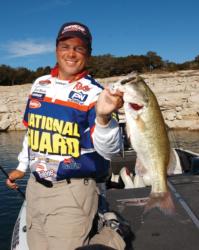 When he wants to swim a spoon at a faster pace, Martin dresses it with a 3-inch boot-tail grub. It gives the spoon more vibration and lets it swim deeper. Martin plays with the retrieve to give the bass exactly what they want. He swims it across the surface and as deep as 3 feet. He varies the depth by speeding up or slowing down the retrieve speed and by his line selection.
When he wants to swim a spoon at a faster pace, Martin dresses it with a 3-inch boot-tail grub. It gives the spoon more vibration and lets it swim deeper. Martin plays with the retrieve to give the bass exactly what they want. He swims it across the surface and as deep as 3 feet. He varies the depth by speeding up or slowing down the retrieve speed and by his line selection.
Depth control
If it’s a warm, overcast day when the bass are snapping, Martin ties a gold Johnson spoon dressed with a 4-inch twin-tail to 25-pound Berkley Big Game monofilament. The spoon casts like a rocket, and Martin slings it far out over grass beds.
“That’s when I use a standard medium retrieve,” Martin said. “I want to keep the spoon swimming an inch or two under the surface and popping up on top for a moment when it climbs over a clump of grass.”
On sunny days, Martin opts for a black spoon and a 3-inch twin-tail, a boot-tail grub or a rubber skirt. He also switches to 60-pound super braid, which has the diameter of 12-pound monofilament. The smaller trailers and thinner line let the spoon swim deeper than with the 4-inch twin-tail and 25-pound monofilament, even when retrieved at the same speed.
“With braided line, I can swim the spoon deeper,” Martin said. “I might crawl it along 2 to 3 feet deep, the way I’d slow-roll a spinnerbait. That gets bites when bass aren’t active.”
A 7 1/2-foot flipping stick gets the call when Martin is casting a spoon way out over submerged grass species, such as peppergrass. If he needs to cast into openings and pockets in bulrushes and other emergent grasses, Martin drops back to a 7-foot rod for better accuracy. Both rods are rigged with Abu Garcia Revo baitcasting reels.
Pick of the grasses
Peppergrass yields more bass to Martin’s spoons than any other vegetation. He claims bass flock to peppergrass when the water’s warm, and the grass isn’t so thick that it prevents bass from finding and attacking spoons.
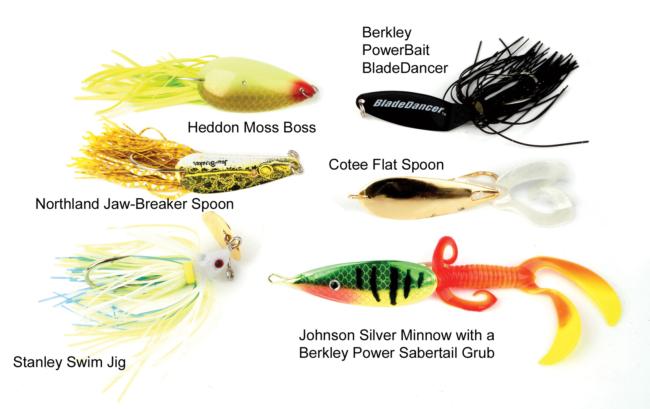 Martin also fares well swimming spoons through emergent grasses, such as bulrushes and wispy Kissimmee grass. The latter is also called maidencane, knotgrass and jointgrass, and it is found in many Florida lakes. When he fishes tournaments beyond Florida’s border, Martin spoons bass from water willows. This plant is similar to Kissimmee grass and grows in the shallows in many natural lakes and reservoirs in the eastern United States.
Martin also fares well swimming spoons through emergent grasses, such as bulrushes and wispy Kissimmee grass. The latter is also called maidencane, knotgrass and jointgrass, and it is found in many Florida lakes. When he fishes tournaments beyond Florida’s border, Martin spoons bass from water willows. This plant is similar to Kissimmee grass and grows in the shallows in many natural lakes and reservoirs in the eastern United States.
“I always throw past Kissimmee grass and jerk my line down through it before I start my retrieve,” Martin said. “That keeps my spoon swimming in the water instead of climbing over stalks of grass.”
You might be surprised to learn Martin rarely fishes hydrilla with a Johnson spoon. He claims hydrilla is so dense that bass have trouble locating and nabbing a spoon in it.
Dancing around bass
You’ll find Berkley’s BladeDancer in pro Jay Yelas’ tackle box. This unique bait has a sharply upturned spoon molded to a jighead. The bend in the spoon lifts the bait and gives it an exaggerated side-to-side sashay. It’s like a Johnson spoon on steroids. Though the original model has an exposed hook, a new Weedless BladeDancer from Berkley sports a wire weedguard.
Both models are available in various sizes and colors and come packaged with Power Minnow Grubs, which have minnow bodies and curly tails. The weedless model also features a skirt to give it more bulk and action.
Yelas of Tyler, Texas, has done well with the Minnow Grubs, but he claims a boot-tail grub like a Berkley Gulp! Shaky Shad gives the BladeDancer a better kicking motion. He relies mainly on a gold spoon with a chartreuse or white trailer and a black spoon with a black trailer.
“There’s nothing out there like the BladeDancer,” Yelas said. “It definitely catches fish under the right conditions.”
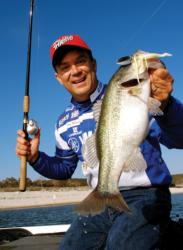 The right conditions are late spring through fall in lily pads, bulrushes and thick submerged vegetation, including hydrilla. He has his best luck with the BladeDancer walking it just under the surface through and over the aquatic growth. To help him horse bass out of the grass, Yelas matches 20- to 30-pound Berkley FireLine to a 7-foot rod with a Daiwa high-speed Viento baitcasting reel.
The right conditions are late spring through fall in lily pads, bulrushes and thick submerged vegetation, including hydrilla. He has his best luck with the BladeDancer walking it just under the surface through and over the aquatic growth. To help him horse bass out of the grass, Yelas matches 20- to 30-pound Berkley FireLine to a 7-foot rod with a Daiwa high-speed Viento baitcasting reel.
“The biggest mistake people make with the BladeDancer is fishing it too fast,” Yelas said. “That bait has so much lift that you’ve got to slow down to keep it running right.”
Yelas fished the BladeDancer patiently when he competed in a Wal-Mart FLW Tour tournament at Lake Okeechobee in January of 2006. He was in the Monkey Box, fishing a variety of grasses in water 2 to 3 feet deep.
“I would flip a little bit when I came to matted grass,” Yelas said. “And I was throwing a Mann’s Baby 1-Minus in the sparser grass. When I came to grass that was too thick for the 1-Minus, I’d cast the BladeDancer in there and swim it back about 6 inches under the surface.”
Yelas started strong on the first day of the tournament with a limit that weighed nearly 14 pounds. On the second day, he caught only four small bass that totaled a little over 4 pounds. Despite a poor second day, he finished in 52nd place.
Successful swimming
Pro Sean Hoernke of Magnolia, Texas, has been fishing the Stanley Swim Jig for the past three years. 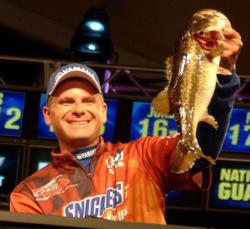 He said it wobbles like a Johnson spoon but shows bass a jig profile. It’s a juiced-up jig, but it’s more subtle than a vibrating cranking jig, such as a ChatterBait.
He said it wobbles like a Johnson spoon but shows bass a jig profile. It’s a juiced-up jig, but it’s more subtle than a vibrating cranking jig, such as a ChatterBait.
Available in various sizes and colors, the Stanley Swim Jig is dressed with a silicone skirt and has what appears to be a Colorado blade molded to its nose. A clear nylon brushguard lets you swim this bait through grass, tree limbs and brushy cover without snagging.
Hoernke got hooked on the Swim Jig when he competed in a Wal-Mart Texas Tournament Trail event at Lake Texoma in April of 2004. The hot pattern was fishing marina docks.
“It was a traditional postspawn deal,” Hoernke said. “The bass were suspended 4 to 5 feet deep under docks floating over 20 to 40 feet of water.”
During that event, it seemed to Hoernke that every competitor was retrieving a spinnerbait or swimming a regular jig down the length of the docks. He had no choice but to get in line and fish behind other anglers all day. Hoernke knew he had to show the bass something different. That something was a Stanley Swim Jig.
“I was running the Swim Jig 6 inches deep next to the Styrofoam under the docks and catching bass right behind other fishermen,” Hoernke said.
When the two-day event was over, Hoernke claimed fourth place with 10 bass that weighed 24 pounds, 11 ounces. Swimming spoons have added crucial pounds to his tournament catches many times since.
Hoernke’s go-to Swim Jig colors are white and a black/blue combination. He dresses the bait with a regular plastic jig chunk, which lifts the bait and gives it a nice wobble. A steady retrieve that keeps the Swim Jig within 2 feet of the surface produces the most bites for him. However, he has taken bass as deep as 5 feet with it.
Armed with a 7-foot medium-heavy baitcasting rod and 20-pound monofilament, Hoernke casts the Swim Jig to shallow cover that most fishermen probe with spinnerbaits. This includes docks, shallow emergent grass, submerged grass, windfalls and brush piles. He fares best with the lure from April through June, after the bass have spawned. When he’s fishing hydrilla in the spring, Hoernke goes to the backs of pockets and slow-rolls a Swim Jig over grass that tops out 2 to 3 feet under the surface.
Wherever Hoernke fishes, the water must be clear to lightly stained before he casts the Swim Jig. He 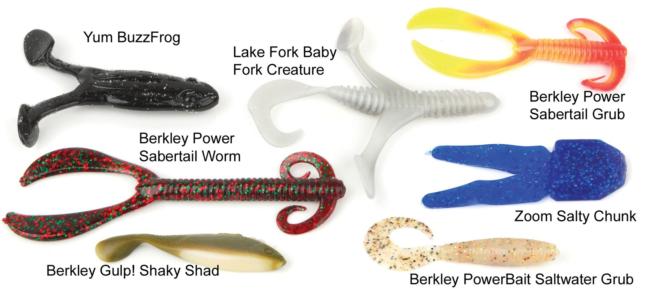 claims the lure is too subtle to attract bass in muddy water. In muddy conditions, he’s more inclined to use something like a cranking jig that makes a commotion.
claims the lure is too subtle to attract bass in muddy water. In muddy conditions, he’s more inclined to use something like a cranking jig that makes a commotion.
Trailer tricks
An offbeat trick that has paid off for Scott Martin is dressing a Johnson spoon with a watermelon red glitter Berkley Power Jerkshad. It gives the spoon a bigger profile and makes it swim with a more exaggerated wobble.
“It’s something I do when bass are spawning heavily in an area,” Martin said. “I reel it very slowly on the bottom. The bass get worked up when they see that thing crawling through their beds. There are more applications for that spoon than just throwing it out and reeling it back in the old traditional way.”